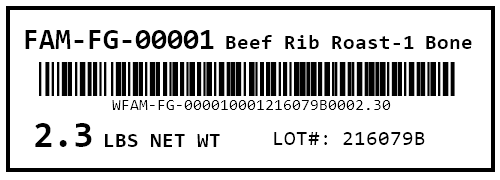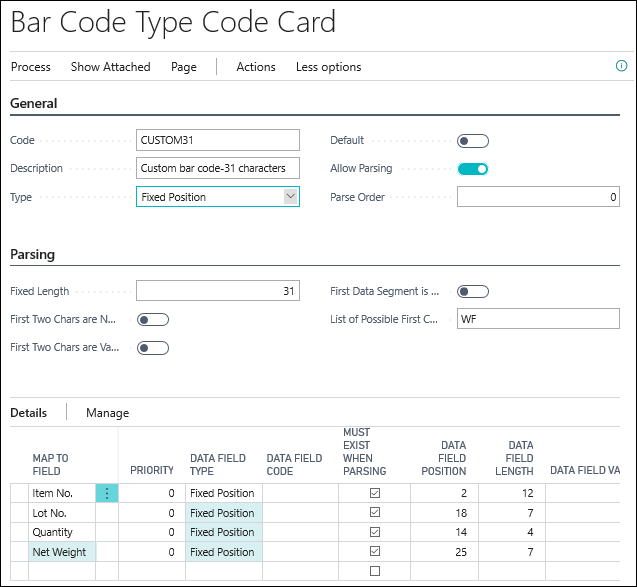Set Up Fixed Position Bar Codes
If your company creates their own custom Bar Codes that always have the same format, you must set up a Fixed Position Bar Code, which will allow you to scan your custom Bar Codes during warehouse processes.
Example
Your company creates a Bar Code that always includes the same information. The custom Bar Code is always 31 characters, and includes the following information:
Position 1: Letter that indicates if the item is a variable weight item (W) or a fixed weight item (F).
Position 2-13: Item number, which is always 12 characters.
Position 14-17: Quantity, which is always 4 characters.
Position 18-24: Lot number, which is always 7 characters.
Position 25-31: Weight, which is always is always 7 characters.

This sample Bar Code includes the following information:
W: Indicates the item is a variable weight item.
FAM-FG-00001: Item number.
0001: Quantity of 1.
216079B: Lot number.
0002.30: Weight.
To be able to scan these labels, a Bar Code is set up as follows:

To set up Fixed Position Bar Codes
Choose
 , enter bar code types, and then choose the related link.
, enter bar code types, and then choose the related link.The Bar Code Types page opens.
On the action bar, choose New.
The Bar Code Type Code Card page opens.
On the General FastTab, perform the following steps:
In the Code field, enter a code to represent the bar code.
In the Description field, enter a description of the bar code.
In the Type field, select Fixed Position.
Ensure that Default is turned off.
Default bar codes only work with GS1-128 bar codes.
Turn on Allow Parsing.
When Allow Parsing is turned on JustFood considers this Bar Code Type when trying to match a scanned Bar Code with a Bar Code Type Code.
In the Parse Order field, enter the order in which a Bar Code is to be considered when trying to match a scanned Bar Code with a Bar Code Type Code.
The lower the number, the higher the priority.
The Parsing FastTab includes the information that allows JustFood to determine whether an incoming scanned Bar Code matches a Bar Code Type. On the Parsing FastTab, perform the following steps:
In the Fixed Length field, enter the length of your custom Bar Code.
If the first two digits of your bar code are numbers, turn on First Two Chars are Numeric.
Ensure that First Two Chars are Valid AI is turned off.
Ensure that First Data Segment is Valid AI is turned off.
In the List of Possible First Chars field, if you have particular characters that always start your bar code, enter them here.
If you have more than one starting character, enter them without spaces. For example, if a bar code starts with either V, F, or X, enter VFX.
The Details FastTab provides the capability for you to indicate what the data in the Bar Code represents. On the Details FastTab, perform the following steps:
In the Map To Field field, select the field that the scanned data will be mapped to.
In the Priority field, leave the value as 0.
In the Data Field Type field, select Fixed Position.
Leave the Data Field Code blank.
To specify that the data field must exist when the Bar Code is scanned, select the Must Exist when Parsing check box.
In the Data Field Position field, enter the position that the data field starts.
In the Data Field Length field, enter the length of the data field.
Leave the Data Field Value blank.
In the Description field, enter a description of the line.